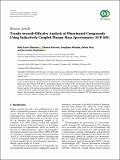| dc.contributor.author | Moirana, Ruth | |
| dc.contributor.author | Kivevele, Thomas | |
| dc.contributor.author | Mkunda, Josephine | |
| dc.contributor.author | Mtei, Kelvin | |
| dc.contributor.author | Machunda, Revocatus | |
| dc.date.accessioned | 2021-02-15T13:35:52Z | |
| dc.date.available | 2021-02-15T13:35:52Z | |
| dc.date.issued | 2021-02-03 | |
| dc.identifier.uri | https://doi.org/10.1155/2021/8837315 | |
| dc.identifier.uri | https://dspace.nm-aist.ac.tz/handle/20.500.12479/1118 | |
| dc.description | This research article published by Hindawi, 2021 | en_US |
| dc.description.abstract | Increased demand for monitoring and identification of novel and unknown fluorinated compounds (FCs) has demonstrated the need of sensitive fluorine-specific detectors for unknown FCs in both biological and environmental matrices. Inductively coupled plasma mass spectrometry (ICP-MS) is a promising technique for analysis of FCs and has been rated as the most powerful tool in analytical chemistry. However, direct determination of fluorine using this technique is challenged by high ionization potential of fluorine together with spectral and nonspectral interferences which affect the quality of results. To enhance the quality of results, several studies have reported modifications of a conventional ICP-MS analysis procedure on sample preparation, introduction, analysis, and instrument optimization. Therefore, the focus of this study is to discuss different ICP-MS optimizations and future trends towards the effective analysis of FCs using ICP-MS. | en_US |
| dc.language.iso | en | en_US |
| dc.publisher | Hindawi | en_US |
| dc.subject | Research Subject Categories::NATURAL SCIENCES | en_US |
| dc.title | Trends towards Effective Analysis of Fluorinated Compounds Using Inductively Coupled Plasma Mass Spectrometry (ICP-MS) | en_US |
| dc.type | Article | en_US |

